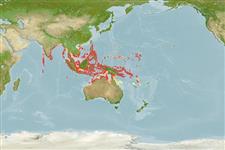Teleostei (teleosts) >
Eupercaria/misc (Various families in series Eupercaria) >
Caesionidae (Fusiliers) > Caesioninae
Etymology: Pterocaesio: Greek, pteron = wing, fin + Latin, caesius = blue grey (Ref. 45335).
Environment: milieu / climate zone / depth range / distribution range
Ecology
Marine; reef-associated; non-migratory; depth range 1 - 30 m (Ref. 90102). Tropical; 23°N - 20°S, 72°E - 171°E (Ref. 402)
Indo-West Pacific: Sri Lanka to Vanuatu (New Hebrides).
Size / Weight / Age
Maturity: Lm ? range ? - ? cm
Max length : 25.0 cm TL male/unsexed; (Ref. 402); common length : 18.5 cm SL male/unsexed; (Ref. 37816)
Dorsal
spines
(total): 10 - 11;
Dorsal
soft rays
(total): 14-16;
Anal
spines: 3;
Anal
soft rays: 11 - 13. This species is distinguished by the following characters: D X (rarely XI),15 (rarely 14 or 16); A III,12 (11-13); pectoral fin 20-22 soft rays; scales in lateral line usually 69-75, above to dorsal fin origin 9-11 (modally 10) and below to anal-fin origin 11-12; upper peduncular scales usually 11-13; dorsal and anal fins are scaly; obliquely oriented scale rows on posterior back; two postmaxillary processes; small conical teeth in jaws; greatest body depth 3.3-4.4 in SL, head length 3.2-3.7 in SL; colour of body bluish green on upper half, white or silvery blue on lower side (pinkish ventrally); a single yellow longitudinal stripe laterally, about 1 scale wide, covering lateral line for most of its length, usually running dorsal to lateral line on caudal peduncle; caudal fin dusky, the tips of lobes black (Ref. 68703, 90102).
Inhabits clear coastal to outer reef slopes or drop-offs (Ref. 48636). Feeds on zooplankton in midwater aggregations. Oviparous, with numerous, small pelagic eggs (Ref. 402). Caught mainly by drive-in-nets.
Life cycle and mating behavior
Maturity | Reproduction | Spawning | Eggs | Fecundity | Larvae
Carpenter, K.E., 1987. Revision of the Indo-Pacific fish family Caesionidae (Lutjanoidea), with descriptions of five new species. Indo-Pac. Fish. (15):56 p. (Ref. 1723)
IUCN Red List Status (Ref. 130435)
Threat to humans
Harmless
Human uses
Fisheries: commercial
More information
Common namesSynonymsMetabolismPredatorsEcotoxicologyReproductionMaturitySpawningSpawning aggregationFecundityEggsEgg development
ReferencesAquacultureAquaculture profileStrainsGeneticsElectrophoresesHeritabilityDiseasesProcessingNutrientsMass conversion
Tools
Special reports
Download XML
Internet sources
Estimates based on models
Preferred temperature (Ref.
123201): 27.7 - 29.3, mean 28.8 °C (based on 2058 cells).
Phylogenetic diversity index (Ref.
82804): PD
50 = 0.5002 [Uniqueness, from 0.5 = low to 2.0 = high].
Bayesian length-weight: a=0.01318 (0.00701 - 0.02480), b=3.16 (3.00 - 3.32), in cm total length, based on LWR estimates for this species & Genus-body shape (Ref.
93245).
Trophic level (Ref.
69278): 3.4 ±0.45 se; based on food items.
Resilience (Ref.
120179): High, minimum population doubling time less than 15 months (Preliminary K or Fecundity.).
Fishing Vulnerability (Ref.
59153): Low vulnerability (15 of 100).
Nutrients (Ref.
124155): Calcium = 76.6 [50.3, 121.8] mg/100g; Iron = 0.84 [0.54, 1.24] mg/100g; Protein = 19 [18, 20] %; Omega3 = 0.142 [0.095, 0.210] g/100g; Selenium = 28.4 [17.8, 49.7] μg/100g; VitaminA = 112 [46, 285] μg/100g; Zinc = 1.29 [0.93, 1.74] mg/100g (wet weight);
